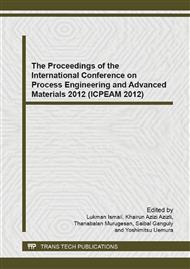[1]
C.I.F. Ferreira, CO2/CH4 Separation with ionic liquids, in: Dept. Chem., Univ Aveiro, Aveiro, Portugal, (2010).
Google Scholar
[2]
W.J. Schell, C.D. Houston, In Membrane Gas Separations for Chemical Process and Energy Application, in: Indusrial Gas Separation, 1983, pp.125-143.
Google Scholar
[3]
I. Cabasso, K.A. Lundy, method of making membranes for gas separation and the composite membranes, in, United States, (1986).
Google Scholar
[4]
M. Mulder, Basic Principles of Membrane Technology Second Edition, 2 ed., Kluwer Academic Publishers, Netherlands, (1996).
Google Scholar
[5]
B.C. Ng, H. Hasbullah, A.F. Ismail, W.A.W. Abdul Rahman, Formation of asymmetric polysulfone flat sheet membrane for gas separation: rheological assessment, in: Regional Symp on Membrane Sci and Technology Johor, Malaysia, (2004).
DOI: 10.11113/jt.v41.720
Google Scholar
[6]
W. -J. Lee, D. -S. Kim, J. -H. Kim, Preparation and gas separation properties of asymmetric polysulfone membranes by a dual bath method, korean journal of chemical engineering, 17 (2000) 143-148.
DOI: 10.1007/bf02707135
Google Scholar
[7]
P. Hacarlioglu, L. Toppare, L. Yilmaz, Effect of preparation parameters on performance of dense homogeneous polycarbonate gas separation membranes, Journal of Applied Polymer Science, 90 (2003) 776-785.
DOI: 10.1002/app.12505
Google Scholar
[8]
G.C. Kapantaidakis, S.P. Kaldis, G.P. Sakellaropoulos, E. Chira, B. Loppinet, G. Floudas, Interrelation between phase state and gas permeation in polysulfone/polyimide blend membranes, J Polym Sci Pol Phys, 37 (1999) 2788-2798.
DOI: 10.1002/(sici)1099-0488(19991001)37:<2788::aid-polb8>3.0.co;2-l
Google Scholar
[9]
a. tabe-mohammadi, j. p. g. villaluenga, h. j. kim, t. chan, v. rauw, effects of polymer solvents on the performance of cellulose acetate membrane in methanol-methyl tertiary buthyl ether separation, (2001).
DOI: 10.1002/app.2144
Google Scholar
[10]
A.F. Ismail, P.Y. Lai, Development of defect-free asymmetric polysulfone membranes for gas separation using response surface methodology, Separation and Purification Technology, 40 (2004) 191-207.
DOI: 10.1016/j.seppur.2004.02.011
Google Scholar
[11]
H.J. Kim, R.K. Tyagi, A.E. Fouda, K. Ionasson, The kinetic study for asymmetric membrane formation via phase-inversion process, Journal of Applied Polymer Science, 62 (1996) 621-629.
DOI: 10.1002/(sici)1097-4628(19961024)62:4<621::aid-app5>3.0.co;2-v
Google Scholar
[12]
A.F.I. M.A. Aroon, M.M. Montazer-Rahmati, T. Matsuura, Morphology and permeation properties of polysulfone membranes for gas separation: Effects of non-solvent additives and co-solvent, Separation and Purification Technology, 72 (2010) 194-202.
DOI: 10.1016/j.seppur.2010.02.009
Google Scholar
[13]
H.J. Kim, S.I. Hong, The transport properties of CO2 and CH4 for chemically modified polysulfones, J Appl Polym Sci, 76 (1999) 391-400.
DOI: 10.1002/(sici)1097-4628(20000418)76:3<391::aid-app14>3.0.co;2-5
Google Scholar
[14]
J.A. Hof van 't, A.J. Reuvers, R.M. Boom, H.H.M. Rolevink, C.A. Smolders, Preparation of asymmetric gas separation membranes with high selectivity by a dual bath coagulation method, Journal membrane science, 70 (1992) 17-30.
DOI: 10.1016/0376-7388(92)80076-v
Google Scholar
[15]
A.F. Ismail, P.Y. Lai, Effects of phase inversion and rheological factors on formation of defect-free and ultrathin-skinned asymmetric polysulfone membranes for gas separation, Separation and Purification Technology, 33 (2003) 127-143.
DOI: 10.1016/s1383-5866(02)00201-0
Google Scholar
[16]
S.S. Madaeni, P. Moradi, Preparation and characterization of asymmetric polysulfone membrane for separation of oxygen and nitrogen gases, Journal of Applied Polymer Science, 121 (2011) 2157-2167.
DOI: 10.1002/app.33804
Google Scholar
[17]
S. Rafiq, Z. Man, A. Maulud, N. Muhammad, S. Maitra, Effect of varying solvents compositions on morphology and gas permeation properties on membranes blends for CO2 separation from natural gas, J Membrane Sci, 378 (2011) 444-452.
DOI: 10.1016/j.memsci.2011.05.025
Google Scholar
[18]
W.A.W.A. Rahman, Formation and characterization of mixed matrix composite materials for efficient energy gas separation, in: U.T. Malaysia (Ed. ), Universiti Teknologi Malaysia, Malaysia, (2005).
Google Scholar
[19]
A.S. Wiryotmojo, H. Mukhtar, Z. Man, Development of polysulfone carbon molecular sieves mixed matrix membranes for CO2 removal from natural gas, in: International Conference on Chemical, Biological and Environemntal Engineering, Singapore, (2009).
DOI: 10.1142/9789814295048_0052
Google Scholar



